N. Gemini Sasson's Blog, page 6
March 17, 2014
Book Signing - Springfield Writes Author Fair - April 26th




Hey All! I'll be at the Springfield Writes Author Fair , with signed paperbacks of all my books available.
Hope to meet some of you there!
Date/time: Saturday, April 26th, 2014 / 1:00-4:00 PM
Location: Clark County Public Library—201 South Fountain Avenue, Springfield, Ohio
Until later,
Gemi

Published on March 17, 2014 11:00
February 26, 2014
Say No More is available on Kindle!
 It's here! It's here! It's here!!!
It's here! It's here! It's here!!!Say No More , my 8th book and my first dog story, is now available on Kindle worldwide. Halo is a compilation of the many wonderful dogs I've been privileged to know over the years. If you're an Amazon Prime member, you can even borrow it for free.
Ever heard of a place called the Rainbow Bridge? Ever lost a loved one, but sensed that they were still there beside you?
Don't expect any history in this novel (unless you consider Bernadette's retelling of the founding of the Faderville Library to be of historical significance). What you can expect are some poignant moments between an Australian Shepherd named Halo and her people, a surprising amount of action as Halo perseveres to find her way home despite a scheming villain who has other plans for her, and a message about the power of love and the extent of a dog's loyalty.
The paperback will be available in a couple of weeks. Meanwhile, here are some of the Amazon links:
Amazon.com (U.S.)
Amazon.uk (UK)
Amazon.ca (Canada)
Amazon.de (Germany)
Amazon.au (Australia)
Here's the Prologue:
***
prologue
A thousand scents surround me: honeysuckle and hyacinth, grubs burrowing through damp earth, stagnant water mingling with black muck at pond’s edge … and bacon frying. I lick my lips and swallow. It’s all I can do to not put my nose to the air and explore until I discover their source. But I have to stay here. It’s almost time.I have something very important to do. I’m waiting. For him. And I’ll be here when he comes. The first one he’ll see. It seems like it’s been forever, yet I can remember every detail about him, as if I left him only minutes ago.Tender shoots of spring grass tickle my feet. I lower my head until my chin rests on the ground and nibble at them while I wait. After all, I don’t know how long it will be. To my right, a beetle scampers down a blade of grass before disappearing into the dense carpet of green. My ears perk. I swear I hear its tiny feet rustling. Or maybe that’s the sound of its jaws sawing away on moist stems?The barest of breezes tugs at my hair. There is a fluttering inside my nostrils. I lift my head, inhale. It’ll rain soon. I know it before I hear the low rumble in the sky or see the clouds darkening on the horizon. I’m not scared of the thunder here. I became that way when I was old. In The Time Before This. But now I’m young again. Here, there is excitement in everything, wonder in the familiar. Rising, I look toward the top of the hill where the great oak stands. Its boughs are twice as thick around as my middle. Its crown spreads far, every branch densely cloaked in leaves of green. In sunlight, it shields me from the heat. In rain, it keeps me dry. When the wind kicks up and the air cools, there is a little pocket in the earth between the sprawling roots where I have dug a hole and can curl up. Here, no one cares if I dig. It is expected. The walk is long and steep, but my bones do not weary. I am young again. And I would climb a hill ten times as high, ten times over, ten days straight, just to see him one more time. My heart leaps at the thought.He’ll come. I know he will. As I reach the top, a squirrel darts forth and stares me straight in the eye. My heart quickens. Her gray tail stiffens above her back like a bottle brush, then flicks to the side. Whiskers twitch nervously. I crouch in the tall grass, watching, patient. Boldly, she races forward and plucks an acorn from the ground. She clutches it to her chest, as if to say, “Mine, mine, mine.” Stupid beady-eyed creature. I don’t want the acorn. I can think of tastier things. Squirrel, for one.I lift a foot, creep forward, pause, step again. Her tail quivers. My head low, I move through the grass. So close now I can smell the wood scent on her fur and —“Halo! Haaaloooooo!”In a blur, the squirrel whips around and scrabbles up the furrowed bark of the oak, the knobby acorn stuffed in her tiny mouth. She stops above the first bough, gazes down at me, and huffs her cheeks in triumph. Then with another arrogant flick of her tail, she ascends in a spiral, and I lose her form in the tangle of branches and scattering of leaves. Far above, baby squirrels chatter in greeting.“Halo?” the Old Man calls. “What’re you doing up there, girl?”At the base of the hill, the Old Man stands, gripping a shepherd’s crook. It’s merely for show. I suppose it makes him feel important, like he’s in charge of things, but I don’t really need him to tell me what to do. At least not as much as he thinks.He walks partway up, tapping the bottom of the crook along the ground as he goes. Here, he doesn’t need it to lean on. His steps are slow but sure. His spine, once bent, is now straight and strong. He reaches the top of the hill, his breath barely audible, but a sheen of sweat glistens above his brow. My belly low, I slink to him, then sit and wait obediently. Gone from his face is the mapwork of blue veins beneath papery skin, although there are still creases around his eyes from squinting into the sun for so many years. He reaches his hand out, lets it hover above my head. I sniff his fingers. They’re still spotted with age, but they’re no longer gnarled. He scratches gently behind my ears. I lean against his knee as his fingernails tickle my neck and then my back.“Come on, Halo. We have to move the sheep before the storm blows in.”Silly man. There are no coyotes here. They have their own heaven, separate from ours.He steps away and pats his leg, but I don’t move. Doesn’t he understand? I’m waiting for someone. What if he finally shows up and I’m not here? I can’t leave my post. This is my job, my responsibility, my duty. Mine alone. My honor depends on it.The Old Man frowns sympathetically at me. His shoulders lift in a shrug, emphasizing the wrinkles in that same old tatty shirt he always wears. I’ve always loved the smell of it and hated whenever he washed it. I hate the smell of soap. And shampoo. Things should smell as they’re meant to, not like almonds or coconut milk or baby powder.“We were quite a team, weren’t we, girl?” His mouth curves into a grin. Crinkles form at the corners of his eyes.“All the ribbons, the belt buckles . . .” His voice softens as he reminisces. “All those titles . . . But they don’t really mean a thing, do they?”No, they don’t. They’re only things: colored scraps of cloth, metal discs, letters on a piece of paper. What matters were the many hours we spent in the field gathering the sheep, the cold mornings when we tiptoed into the barn to check on the new lambs, the times he let me ride in the cab of the pick-up next to him. I worked hard then, but I was happy. So was he. There was pride in a good day’s work. “You were always there when I needed you, Halo. Always. That’s what matters.”“It is,” I say. “And you were there for me.”Nodding, he turns to go, the wooden staff trailing behind him. The grass ripples in a rising wind and the bleating of sheep carries across the valley. Do the simple creatures ever tire of being afraid?I gaze across the river, over the arc of many colors that is the bridge to here: the Other Side. There’s no one there. Yet. If I hurry, I can help the Old Man and be back before the boy comes.And he will. Because I’m waiting. Like any good dog would.
***
Remember to leave a review once you've read Say No More. Reviews help other readers decide if this book may be right for them. And if you like it, don't forget to tell your friends via Facebook or Twitter! Word of mouth is the most powerful tool available to indie authors and readers are the ones who spread the word. Thanks for all your support!
Happy reading,Gemi

Published on February 26, 2014 06:50
February 21, 2014
Cover Reveal for Say No More
 Here it is! The cover for my upcoming novel,
Say No More
, done by the mega talented Jason Gurley. You may have seen some of his covers already on indie bestsellers like Hugh Howey's
Sand Omnibus
and A.G. Riddle's
The Atlantis Plague
. Both books are knock-your-socks-off awesome, inside and out. (BTW, Jason is also a gifted writer himself.)
Here it is! The cover for my upcoming novel,
Say No More
, done by the mega talented Jason Gurley. You may have seen some of his covers already on indie bestsellers like Hugh Howey's
Sand Omnibus
and A.G. Riddle's
The Atlantis Plague
. Both books are knock-your-socks-off awesome, inside and out. (BTW, Jason is also a gifted writer himself.)For Say No More's cover, Jason did a fabulous job of capturing the loyalty of a dog and the underlying mystical elements in the story.
This book is something I've had brewing for a looooong time and I'm super excited about its release. It stems from my decades of owning, training, and breeding Australian Shepherds. I've been tremendously privileged to have so many great dogs as part of my life, from childhood to the present, and each has held a special place in my heart. I've felt so connected to some of them that when it was their time to go, their absence left me to grieve deeply. That connection can be so strong that I feel like it's never truly severed. And I'd like to believe that we see our loved ones again - be they human, canine, feline, equine or anything else.
Say No More should be available on Kindle and in paperback in the coming week, but for now, here's the description:
*****
SAY NO MORE
A dog’s love is forever.
After five-year old Hunter McHugh witnesses the farming accident that takes the life of his father, Cam, he stops talking — to everyone except his dog, Halo. When Hunter runs away and gets lost in the Kentucky wilderness, it’s up to Halo to find him. Just as she’s about to give up, Halo gets help from an unlikely source: Cam’s ghost.Halo is no ordinary dog. Not only does she see ghosts, but she can talk to them, too. If only she could tell Hunter that death doesn’t mean an end to being around the ones we love, maybe she could help him find his voice again. Unfortunately, she may never have the chance.Parted from the only family she has ever known, Halo must find her way home. The problem is she doesn’t know where home is anymore. Say No More is a heartfelt story of loss, hope, and the enduring bond between a boy afraid to speak and a dog that can’t.
*****
I'll post here on my blog, on Facebook and my web site when it's available. So stay tuned!
Oh, and all the beta readers tell me they got weepy at the end, so keep the tissues nearby. One of them even described it as a cross between Black Beauty (the canine version) and The Incredible Journey/Homeward Bound.
Until later,
Gemi

Published on February 21, 2014 12:48
February 19, 2014
What to Read Next - February, 2014
Where do I start? One huge advantage of the fierce winter weather that has restricted my running to the treadmill is that I'm getting a LOT of reading done this winter while I crank out the miles. So here are my favorites of all the books I've read in the last few months. Check them out and if you discover a book you enjoy, share it with your friends on Facebook and Twitter.
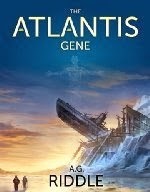 The Atlantis Gene, by A.G. Riddle
The Atlantis Gene, by A.G. Riddle
"70,000 years ago, the human race almost went extinct.
We survived, but no one knows how.
Until now.
The countdown to the next stage of human evolution is about to begin, and humanity might not survive this time."
What I love most about reading on my Kindle is trying new genres and finding new authors. A.G. Riddle is tremendously talented. The Atlantis Gene will take you on a thrilling, action-packed ride steeped in evolutionary science and history. Riddle has obviously put a great amount of thought and research into this story.
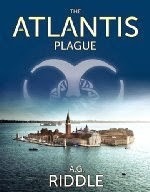 The Atlantis Plague, by A.G. Riddle
The Atlantis Plague, by A.G. Riddle
"In Marbella, Spain, Dr. Kate Warner awakens to a horrifying reality: the human race stands on the brink of extinction. A pandemic unlike any before it has swept the globe. Nearly a billion people are dead--and those the Atlantis Plague doesn't kill, it transforms at the genetic level. A few rapidly evolve. The remainder devolve."
The sequel to The Atlantis Gene is even better, if that's possible. It pretty much knocked my socks off. All the threads begin to come together as you read along and Kate and David's relationship deepens. Action, suspense and mystery with a healthy dose of science and history.
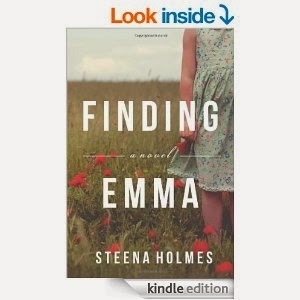 Finding Emma, by Steena Holmes
Finding Emma, by Steena Holmes
"A mother’s near-obsessive devotion to her missing daughter threatens to destroy more than one family.
Megan is the harried but happy stay-at-home mother of three little girls living in a small town. Her life implodes when her youngest daughter, Emma, disappears on her third birthday."
An element of mystery surrounds this touching story of an abducted child and the bond that develops with her abductors, and her mother's quest to find her. This had me tearing up at the end.
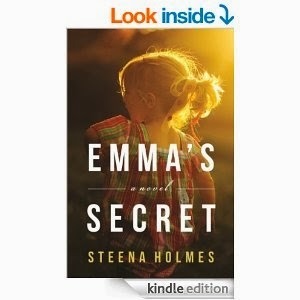 Emma's Secret, by Steena Holmes
Emma's Secret, by Steena Holmes
A continuation of Finding Emma. I'll skip the description so there aren't any spoilers, but this is a worthy follow-up to its prequel.
Happy reading!
Gemi

 The Atlantis Gene, by A.G. Riddle
The Atlantis Gene, by A.G. Riddle
"70,000 years ago, the human race almost went extinct.
We survived, but no one knows how.
Until now.
The countdown to the next stage of human evolution is about to begin, and humanity might not survive this time."
What I love most about reading on my Kindle is trying new genres and finding new authors. A.G. Riddle is tremendously talented. The Atlantis Gene will take you on a thrilling, action-packed ride steeped in evolutionary science and history. Riddle has obviously put a great amount of thought and research into this story.
 The Atlantis Plague, by A.G. Riddle
The Atlantis Plague, by A.G. Riddle
"In Marbella, Spain, Dr. Kate Warner awakens to a horrifying reality: the human race stands on the brink of extinction. A pandemic unlike any before it has swept the globe. Nearly a billion people are dead--and those the Atlantis Plague doesn't kill, it transforms at the genetic level. A few rapidly evolve. The remainder devolve."
The sequel to The Atlantis Gene is even better, if that's possible. It pretty much knocked my socks off. All the threads begin to come together as you read along and Kate and David's relationship deepens. Action, suspense and mystery with a healthy dose of science and history.
 Finding Emma, by Steena Holmes
Finding Emma, by Steena Holmes
"A mother’s near-obsessive devotion to her missing daughter threatens to destroy more than one family.
Megan is the harried but happy stay-at-home mother of three little girls living in a small town. Her life implodes when her youngest daughter, Emma, disappears on her third birthday."
An element of mystery surrounds this touching story of an abducted child and the bond that develops with her abductors, and her mother's quest to find her. This had me tearing up at the end.
 Emma's Secret, by Steena Holmes
Emma's Secret, by Steena Holmes
A continuation of Finding Emma. I'll skip the description so there aren't any spoilers, but this is a worthy follow-up to its prequel.
Happy reading!
Gemi

Published on February 19, 2014 06:54
January 31, 2014
Photos, Stuff, and Memories
 Everyone knows what a horrid winter 2014 has been in the Midwest. We've been hit by major snow events so many times I've lost count. Being one of those who usually sinks into a funk during these months, it's been a struggle to cope. Exercise helps. Reading gets me through a lot of days when we're snowbound. So does staying busy with indoor home projects.
Everyone knows what a horrid winter 2014 has been in the Midwest. We've been hit by major snow events so many times I've lost count. Being one of those who usually sinks into a funk during these months, it's been a struggle to cope. Exercise helps. Reading gets me through a lot of days when we're snowbound. So does staying busy with indoor home projects.The basement is always a target for purging and reorganizing. Let's face it, we all have that place in our house where we 'store' things, be it basement, attic, hall closet, or spare bedroom. Pretty soon, years have gone by and we realize we haven't touched, used or looked at this stuff (anyone remember the George Carlin skit where he says 'a house is just a place for your stuff'?), yet we're reluctant to part with it. Why? Well, lots of reasons, but perhaps the most powerful is that those things connect us to our past and represent a stage in our lives.
Every time I go on one of my purging binges, I debate over what to do with each thing. Throw it in the burn pile? (Great excuse for a bonfire and small get-together with friends.) Put it in the trash? (But, but, but ... it still works!) Put it by the road with a FREE sign on it? (Bet someone regularly collects our reject pile and sells it at their own garage sale.) Have a garage sale? (Nope, no available garage and we're too far off the road, anyway.) Keep it to give to the kids someday when they move out on their own? (Yeah, still waiting on that one.) Give it to Goodwill? (No joke - I've done this and six months later wondered what I did with that nice, seldom-used yellow sweater, because it would go great with this gray shirt.) Auction it on eBay? Sell it on Craigslist? (I probably should, but...)
It's always a dilemma, but I keep telling my kids that I don't want to leave them to sort through a mountain of 'stuff' that's bigger than it needs to be after we're gone. Plus, if we ever move, the less we have to sort through then, the better.
So I force myself (and my husband) to regularly purge. It frees up space and declutters, passes along items that someone else may make better use of, and it allows life to move forward in a new direction.
One of my projects this winter was to tackle the boxes and boxes of photos we've collected over the years. In the past five years or so, my pictures are more and more digital, stuck somewhere on a hard drive or memory card. I both like and dislike this. It's easier to delete the bad pictures and means less physical clutter. But there's also something sacred about having real photo albums to flip through. Each picture marks a step in life. A moment frozen in time. A memory of what was and a realization of what life has since become.
Above is one of my favorite photos. It's of our two kids and one of their best friends after a team race. It speaks not only of their accomplishment (the trophy), but also of their hard work and their friendship. A picture is worth a thousand words, right?
When I look at that picture, I also see what was outside its frame: the barely leafed out trees of spring, the wind rippling across the lake behind them, the other racewalkers who had gathered for the event, and the support crew who counted laps and judged. It also made me realize that we mostly photograph the happy, good events in life, and very seldom the bad ones.
Life is fluid. Made up of moments. Recorded by memories. We cling to pictures and things because we want to remember that life was so often good. The people around us were and are loved. Events were a destination and an experience.
The pictures have been sorted through. Some were tossed. (How many photos of the same puppy pile do you really need?) Others were filed into designated envelopes. The rest were placed in albums.
When you look back at life this way, you don't so much remember what grades you got, what your splits were in the race, which appliance broke that year, or what your annual income was. You remember the way the people, pets, places and events made you feel.
I'm contemplating a future story that deals with this very thing. It's also something the main character in my upcoming novel, Say No More, deals with. Halo (a dog) doesn't like change. But when she looks back over life, she sees that there was far more good than bad to it.
Speaking of which ... Expect a cover reveal next month and a projected publication date for my next novel! I also have a growing list of recommended books I can't wait to share. Lots of fantastic stuff out there from indie authors.
Until later,
Gemi

Published on January 31, 2014 08:06
December 30, 2013
Guest blogging at Tony Riches' The Writing Desk today
Yes, I am still alive and kicking! It's bright outside my cozy writing cave, but I'm possibly days away from finishing book #8 and shooting it off to beta readers. More on that - and thoughts on genre - soon.
First, I direct you all to Tony Riches' blog The Writing Desk where I have a guest post today entitled On Becoming A Writer.
Until later,
Gemi
First, I direct you all to Tony Riches' blog The Writing Desk where I have a guest post today entitled On Becoming A Writer.
Until later,
Gemi

Published on December 30, 2013 05:43
November 17, 2013
Genealogy 101: Digging Roots, Part II, Guest Post by Sandy Frykholm
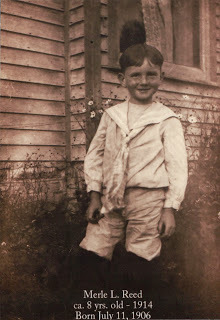
(Merle Reed, ca 1914: The author’s grandfather, whose life journey took him from Iowa to Idaho to Alaska.) Continued from Sandy Frykholm's post on 11-10-13: ***** How do you “document” your research?Modern research is much easier than what we were doing in 1987. The internet is a treasure box of information—AND mis-information. Some researchers are very careful, while others take what seems like the easy road, and assume the best with family trees that others have compiled. Our elderly cousin, Leola, spent years researching our English roots. She shared piles of information with us, in family group sheets and pedigree charts. As a novice, Marlie began looking into some English census documents, and found a few niggling discrepancies—nothing very big—but figured Leola was so much more experienced, she must be right.In 1997, we traveled to England, determined contact some English distant cousins. We put a notice in the Leicester newspaper seeking descendants of our great-great grandparents, and heard from two men. A party was arranged, and one of the men drove us to a nearby city where we could obtain copies of birth, death, and marriage records. When we saw the birth records of our great-grandfather, we were horrified to realize that we were not related to the people we had contacted at all! Fortunately, by the time we gathered that evening, the liquor cabinet was open and everyone was very pleased to meet us, cousins or not. So when I say “document” your research, I mean this: Find documents to confirm any information others provide, and keep copies of the documents, names of books you’ve searched through and people you’ve consulted. Most commonly these are birth, marriage, and death certificates, and census records. Some are fortunate to have detailed information recorded in old family Bibles. For more advanced research, you might look into land ownership and tax records, court documents, and maps. You can find a very clear article here (link to http://ancestry.org/primary-secondary-genealogy-sources/ ) about different kinds of sources used in genealogical research. Compiled genealogies are great starting points—but it is unusual to find their sources clearly identified. If you begin from some one else’s undocumented research (as most of us do), begin documenting right away, so a future reader or researcher can easily determine the accuracy of your information.You can also take advantage of your local genealogical society—many of these have computers available with access to subscription-only genealogy websites. Local societies may include resources for a wide area, and their volunteers are often experienced and well-trained to help with research problems. You can search on the internet to find historical and genealogical societies in the locations your ancestors lived. Societies in distant locations may be willing to provide research for a fee.
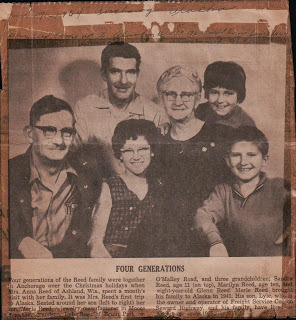 (Reed 4 gen photo: The author, front and center, with her father, grandfather, great grandmother, and siblings in a 1964 photo for the Anchorage, Alaska newspaper.)
(Reed 4 gen photo: The author, front and center, with her father, grandfather, great grandmother, and siblings in a 1964 photo for the Anchorage, Alaska newspaper.) Isn’t everything on the Internet now?Actually, no. But there is a lot!Cyndi’s List ( www.cyndislist.com ) is a holy grail of a website, an enormous collection of links to all kinds of genealogy resources. Anyone doing research online should spend some time there. Many individual have websites about their research. The best way to find these is to search by surname or a combination of surname and location, and include the word ‘genealogy’. Networking with other descendants of your ancestors (your distant cousins) can be enormously helpful in uncovering research others have done. Through one such connection I found a published book taking one family line back to the 1600’s with great documentation.In the USA, the National Archives is a fantastic resource, and their website includes a lot of guidance for a researcher. If you have an ancestor who served in the military, you may be able to find his or her military records, and the Bureau of Land Management has images of original land patents transferring land from the Federal government to homesteaders, pensioners, and others who bought land as the country expanded. The Latter Day Saints (Mormons) are famous for their genealogical collections, and have more than 4,000 family history centers all over the world. These are free of charge and open to anyone doing genealogy. Their website, www.familysearch.org , is also free.The best known subscription website is probably Ancestry.com ( www.ancestry.com ), and a free trial might help you decide if it is worth the price to you. You can view (and save on your own computer) original documents like census records, military records, ships’ passenger lists, as well as connect easily with others researching the same families.
When should you hire a professional? Personally, I love the research and discovery process. If you hate the process, and have the money, by all means hire an expert. Earlier this year I hired some specialized help for two reasons. First, I had a deadline—I was planning a trip to Italy and couldn’t do it myself before I went. Second, even though records were available in Salt Lake City, the source documents were in Italian—and in 18th and 19th century script—which I would likely not have understood even if I found them myself.
What about Chief Joseph?Dad lied. As our research progressed, Marlie and I became more and more skeptical. And as DNA testing has grown in popularity, we convinced our brother to get a test and settle the question. Now we know that we have no Native American DNA. But guess what? We have pioneers, religious dissenters, military veterans, shoemakers and lace-makers, so many other lines of interest now that we can happily set that aside and go on to another challenge.
(Sandy Frykholm is a writer in Washington state. She has written articles, essays, plays, poetry, and two historical novels. Her current writing project involves family history: a memoir about an epic family road trip known as “The Drive in ‘65” which covered more than 20,000 miles in three and a half months, circling North America. She also blogs at www.theitaliansouth.com where you can find some of her Italian genealogy adventures. )*****
Thanks to Julie and Sandy for stopping in and sharing your tips on researching genealogy!
Until later, Gemi
Published on November 17, 2013 12:00
November 10, 2013
Genealogy 101: Digging Roots, Part I, Guest Post by Sandy Frykholm
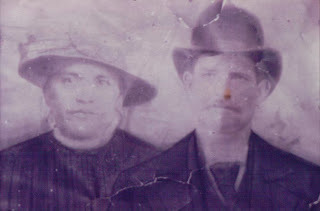 (Josephine (Gualtieri)..etc: The Sandy Frykholm’s Italian great-grandparents, Francesco and Josephine Gualtieri, came through Ellis Island in 1901 before settling on Long Island. He worked in a lace factory in Patchogue, New York.)
(Josephine (Gualtieri)..etc: The Sandy Frykholm’s Italian great-grandparents, Francesco and Josephine Gualtieri, came through Ellis Island in 1901 before settling on Long Island. He worked in a lace factory in Patchogue, New York.) Following Julie Conner's post, Where to Begin , on getting started in researching your family tree, here is the first installment of Sandy Frykholm's in depth advice on the topic.
*****
Digging Roots, by Sandy Frykholm
My dad had no interest in his family history. But long ago he fired up my curiosity by telling us we were descendants of Chief Joseph, the Nez Perce leader. Well, Dad was born in Weippe (wee-ipe) Idaho, Nez Perce territory, so it seemed reasonable enough. Proving his claim was one of the challenges that started my sister Marlie and me on our genealogical quest about 30 years ago.
Where do you start?Because more relatives on my mom’s side were interested, we started gathering information there first. And that is a first rule of genealogy: Start with you. Don’t start with the family mythology that you are descended from George Washington (sorry, but he had no children) or Charlemagne. Start with yourself and work back. You, and the family members who are alive to ask, will be the trunk of your family tree.
How do you keep track of what you find?Recording what you learn, in an organized way, is made easy with blank pedigree charts and family group sheets from a website like http://www.byub.org/ancestors/charts/ . Begin with a pedigree chart, placing yourself as Person #1, and fill in all the information you know. The blanks that are left will show you where to begin your research.Their other forms can guide and help document your research, too. Some can be filled out and saved to your own computer, but if you keep and work mainly with paper files, keep them in sheet protectors in a three ring binder. As your research grows, divide the binders by surname. There are also several genealogy software programs, a great option for the computer savvy, although there are likely to be some paper records you’ll want to keep.
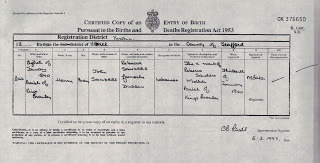 (Birth certificate for the author’s 2nd great grandfather, Henry Sanders,who worked in a brewery in England.)
(Birth certificate for the author’s 2nd great grandfather, Henry Sanders,who worked in a brewery in England.) Do you need to go where your ancestors lived?Marlie and I made our first genealogy trip in 1987 to Weippe, Idaho. We were excited to learn more about our Native American connection. By then we knew that our great-great grandparents had moved to Idaho around 1900, but hadn’t been able to learn where they were buried.Dad’s cousin Barb in Weippe invited a few family members to meet us. We asked our questions. No one knew where the g-g-grandparents were buried. They were sure we wouldn’t find them in the local cemetery—even though that seemed the most likely place to us. When we asked the relatives about the Nez Perce connection, all we got were frowns. No, they were sure there was no Native American in the family tree—and their expressions said they wouldn’t be too happy to find it either. Were they covering up the truth, or was Dad teasing us?Setting that question aside, we went to explore the cemetery. We found the graves of our great grandparents and some of Dad’s aunts and uncles. Then, among the grass stubble we spotted the graves of our great-great grandparents, complete with his military headstone providing a key piece of information about him: the unit he served in during the Civil War. With this we were able to order his military records. If we hadn’t been there in person, it might have been years before we discovered their burial place.Wouldn’t it be great to meet someone who knew your great-great-grandparents? We asked if anyone still living in Weippe might have known them—a stretch, since it had been 50 to 70 years since they died. Barb suggested an elderly neighbor, so Marlie and I walked over and knocked on her door. That was our first experience talking to strangers about the family history, and I recommend it! She did remember them, and told us how he used to tease his wife, and she remembered his long beard. These personal details were priceless to us.Marlie and I have taken several genealogy vacations, and each one has increased our sense of connection with ancestors and their life experience. Standing on the land they farmed, or visiting the village they left behind, cannot be duplicated by a collection of information. You can learn a great deal without going, but I would encourage anyone who can to visit ancestral locations.
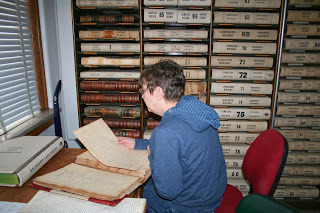
(The author’s sister, Marlie, pores over records in an Ohio courthouse during a 2011 genealogy vacation.)
... To be continued next week...
(Sandy Frykholm is a writer in Washington state. She has written articles, essays, plays, poetry, and two historical novels. Her current writing project involves family history: a memoir about an epic family road trip known as “The Drive in ‘65” which covered more than 20,000 miles in three and a half months, circling North America. She also blogs at www.theitaliansouth.com where you can find some of her Italian genealogy adventures. )
***** More to come later this week from Sandy!
Until then,Gemi

Published on November 10, 2013 12:29
November 3, 2013
Genealogy 101: Where to Begin, A Guest Post by Julie Conner
Have you ever wondered if you have the blood of kings in your DNA? Did your ancestors come to America on the Mayflower?
I've had many people contact me over the last few years who've read my books and told me they're descended from some of the historical figures I've written about. As it turned out, I eventually discovered I was, too!
While I'm no expert on genealogical research, a couple of my former critique group partners, Julie Conner and Sandy Frykholm, have become quite engrossed in digging up their own ancestry. So I asked them to write about how they would advise others to begin researching their roots.
First up is Julie Conner. She has a Master's degree in History and is currently working on a time travel novel. (She's also my NaNoWriMo Buddy!). You can find Julie at http://jeconner.blogspot.com/where she talks about writing, life with Primary Lateral Sclerosis, her obsession with Walt Disney World, and world history. Here are Julie's suggestions on getting started in genealogy:
*****
I’m proud of the fact that I can trace both sides of my family tree to at least the twelfth century, but it’s not something I brag about unless someone brings up the subject of family history into the conversation. Put it this way, I’m not photo bombing strangers pictures yelling, “I’m Lady Godiva’s 30th great grand niece!” as I dash in from the left, arms flailing wildly, or informing the teenage bag boy at my local grocery store, in my best professor voice, “When Sir Henry de Percy, my 22nd great grandfather on my father’s side of the family, met Robert the Bruce, my 21st great grandfather on my mother’s side, I bet they never thought their families would mix together in the twentieth century.” Insert pompous laughter here. I’d be labeled a crazy loon if I did this.
If you’re interested in uncovering where you came from, too, and possibly bragging about your results in a normal way, here’s my advice.
· First, have the complete names and birth/death dates of as many of your direct relatives as possible. Information on your grandparents is good. Information on your great grandparents is better. · Second, find a website devoted to ancestry research. I am addicted to Ancestry.com , but there are multiple free websites that have plenty to offer: familysearch.org , genealogytoday.com , and olivetreegenealogy.com/beginner to name a few.
Once you’ve done these two things, the fun begins…
On familysearch.org , I typed in my name and birth date, my parents’ names and birth dates, and the names and birth dates for both sets of my grandparents. Within seconds of finishing, I knew who my paternal 3rdgreat grandparents were thanks to the Mormon’s excellent record collecting. Easy peasy. If this doesn’t happen for you, and your relatives don’t magically appear on your tree, don’t get discouraged. Try these tools:
· The census: In many cases, a widowed parent lived with one of his or her married children. Look the parent’s name up in a search, match them to a much older census with the same child and their alive spouse, and voila, you have another level of descendants. I also did this with two families who lived beside each other in Pittsburgh, PA. The son of one family married the daughter of another. I couldn’t find the name of the son’s parents until I saw the 1910 census. I matched the two families names and siblings to the married son (a Hillgartner) and daughter (a Winn, who became a Hillgartner) and found the names of both his parents. After I had that, I crosschecked it with an 1890 passenger boat list from Germany to New York City that named the son, and I knew I was correct. All the information clicked.
· Passenger lists, border crossing lists, military draft cards, birth announcements, obituaries, local papers, church registries, and findagrave.com . I can identify the correct birth and death dates sometimes by simply looking at a picture of a tombstone on findagrave.com ! Even google can render amazing finds just by typing in the name of a relative.
Unearthing answers about family history today is as easy as turning on your computer and clicking a mouse. Soon you can run around shouting about who your ancestors are. And if you’re also a great grand niece of Lady Godiva, you’re related to woman who gave generously to the church and lived in England. As for the other story, well…most likely, she never stepped outside her castle naked. Sorry sensationalists and makers of fine, yummy chocolates. She might have ridden a horse through her town while wearing her shift—think nightgown—to make her husband repeal the taxes she’d deemed unfair. Unfortunately, the whole story is probably a myth, a victim of whisper down the centuries, where details were embellished every time the tale was told. But, it’s still fun to imagine the facts are real. I bet the villagers loved her. I wonder what emotions ran through her head while she rode from the castle to the village. Did the sun shine through the tree leaves? Did the wind tussle her long, silky hair? Did her sister encourage her to do this? Was her husband angry or amused? Hmmmm…I believe my next storyline is calling to me…
Julie Conner
*****
Thanks, Julie!
Happy researching, everyone,Gemi
I've had many people contact me over the last few years who've read my books and told me they're descended from some of the historical figures I've written about. As it turned out, I eventually discovered I was, too!
While I'm no expert on genealogical research, a couple of my former critique group partners, Julie Conner and Sandy Frykholm, have become quite engrossed in digging up their own ancestry. So I asked them to write about how they would advise others to begin researching their roots.
First up is Julie Conner. She has a Master's degree in History and is currently working on a time travel novel. (She's also my NaNoWriMo Buddy!). You can find Julie at http://jeconner.blogspot.com/where she talks about writing, life with Primary Lateral Sclerosis, her obsession with Walt Disney World, and world history. Here are Julie's suggestions on getting started in genealogy:
*****
I’m proud of the fact that I can trace both sides of my family tree to at least the twelfth century, but it’s not something I brag about unless someone brings up the subject of family history into the conversation. Put it this way, I’m not photo bombing strangers pictures yelling, “I’m Lady Godiva’s 30th great grand niece!” as I dash in from the left, arms flailing wildly, or informing the teenage bag boy at my local grocery store, in my best professor voice, “When Sir Henry de Percy, my 22nd great grandfather on my father’s side of the family, met Robert the Bruce, my 21st great grandfather on my mother’s side, I bet they never thought their families would mix together in the twentieth century.” Insert pompous laughter here. I’d be labeled a crazy loon if I did this.
If you’re interested in uncovering where you came from, too, and possibly bragging about your results in a normal way, here’s my advice.
· First, have the complete names and birth/death dates of as many of your direct relatives as possible. Information on your grandparents is good. Information on your great grandparents is better. · Second, find a website devoted to ancestry research. I am addicted to Ancestry.com , but there are multiple free websites that have plenty to offer: familysearch.org , genealogytoday.com , and olivetreegenealogy.com/beginner to name a few.
Once you’ve done these two things, the fun begins…
On familysearch.org , I typed in my name and birth date, my parents’ names and birth dates, and the names and birth dates for both sets of my grandparents. Within seconds of finishing, I knew who my paternal 3rdgreat grandparents were thanks to the Mormon’s excellent record collecting. Easy peasy. If this doesn’t happen for you, and your relatives don’t magically appear on your tree, don’t get discouraged. Try these tools:
· The census: In many cases, a widowed parent lived with one of his or her married children. Look the parent’s name up in a search, match them to a much older census with the same child and their alive spouse, and voila, you have another level of descendants. I also did this with two families who lived beside each other in Pittsburgh, PA. The son of one family married the daughter of another. I couldn’t find the name of the son’s parents until I saw the 1910 census. I matched the two families names and siblings to the married son (a Hillgartner) and daughter (a Winn, who became a Hillgartner) and found the names of both his parents. After I had that, I crosschecked it with an 1890 passenger boat list from Germany to New York City that named the son, and I knew I was correct. All the information clicked.
· Passenger lists, border crossing lists, military draft cards, birth announcements, obituaries, local papers, church registries, and findagrave.com . I can identify the correct birth and death dates sometimes by simply looking at a picture of a tombstone on findagrave.com ! Even google can render amazing finds just by typing in the name of a relative.
Unearthing answers about family history today is as easy as turning on your computer and clicking a mouse. Soon you can run around shouting about who your ancestors are. And if you’re also a great grand niece of Lady Godiva, you’re related to woman who gave generously to the church and lived in England. As for the other story, well…most likely, she never stepped outside her castle naked. Sorry sensationalists and makers of fine, yummy chocolates. She might have ridden a horse through her town while wearing her shift—think nightgown—to make her husband repeal the taxes she’d deemed unfair. Unfortunately, the whole story is probably a myth, a victim of whisper down the centuries, where details were embellished every time the tale was told. But, it’s still fun to imagine the facts are real. I bet the villagers loved her. I wonder what emotions ran through her head while she rode from the castle to the village. Did the sun shine through the tree leaves? Did the wind tussle her long, silky hair? Did her sister encourage her to do this? Was her husband angry or amused? Hmmmm…I believe my next storyline is calling to me…
Julie Conner
*****
Thanks, Julie!
Happy researching, everyone,Gemi

Published on November 03, 2013 18:18
October 28, 2013
What to read next - Dog Books!
It's time for my latest recommendations on what to read next! Normally, the list is full of variety, but this time I'm going to zero in on dog books. While it's not hard to find books that feature dogs, it does seem hard to find ones that are really memorable, so I want to share the ones I've come across over the years that have stuck with me.
I loved Donald McCaig's Nop's Trials, but it's not available on Kindle. If you have a dog book favorite, feel free to mention it in the comments below!
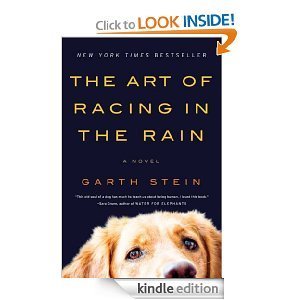
1) The Art of Racing in the Rain , by Garth SteinMy all-time favorite dog book and one of my top 5 favorite anything books. In this novel, we get the dog's perspective as race car driver Denny Swift struggles with his wife's illness, her loss and the threat of losing his daughter to over-controlling in-laws. What makes this story so engaging is Enzo's (the dog's) erudite insight into the happenings in Denny's life. He's loyal, endearing and sometimes opinionated. Stein makes Enzo a totally believable and likeable character and it's impossible not to become totally invested in his life. If you only ever read one dog book, read this one.
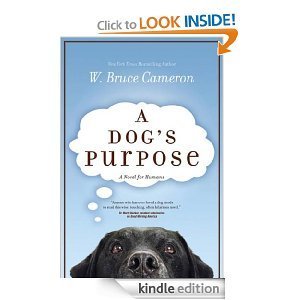 2)
A Dog's Purpose
, by W. Bruce Cameron
2)
A Dog's Purpose
, by W. Bruce Cameron
A close second to Stein's book, A Dog's Purpose follows one dog's soul through several lives as its coul is reincarnated. With each cycle, the dog learns something new about him/herself, people, and life in general. This is a very touching book. For those who've owned several dogs and discovered the unique differences among them, this story gives an insightful perspective to how a dog's mind works and the uniqueness of different breeds.
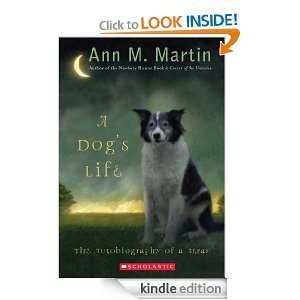
3) A Dog's Life: The Autobiography of a Stray , by Ann M. Martin
Martin's book is appropriate for younger readers, but adults will also enjoy it. A Dog's Life follows the stray-born pup named Squirrel as life takes her through many twists and turns and different homes.
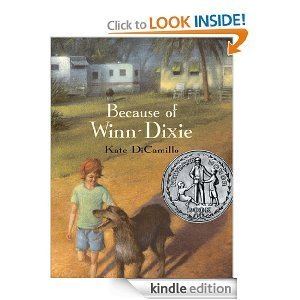
4) Because of Winn-Dixie, by Kate DiCamillo
Another great children's book, Because of Winn-Dixie is about a dog (Winn-Dixie) who helps 10-year old Opal overcome life's previous disappointments by helping her make new friends.
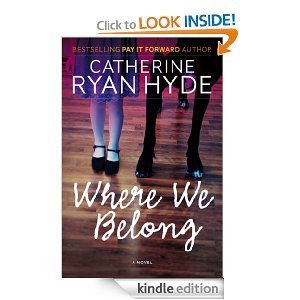
5) Where We Belong, by Catherine Ryan Hyde
While the dog in this story isn't the focus, it does feature very prominently in that autistic Sophie discovers an immediate connection to her. Hyde is one of my favorite authors. Her stories are simple, profound and strike a cord that resonates with all of us. There's often an underlying theme of the adolescent-parent relationship that's on shaky ground and some unusual friendships.

6) Jack: A book about a dog where the dog doesn't die at the end, by Ray Braswell
I had to include something humorous. This one had me laughing out loud - I was glad for that, because I was on a long cross-country trip, so sitting in the airport passed much more quickly. This isn't a story, really. Just a running commentary from a dog's perspective that'll provide a few snorting laughs.
Happy reading,
Gemi

I loved Donald McCaig's Nop's Trials, but it's not available on Kindle. If you have a dog book favorite, feel free to mention it in the comments below!

1) The Art of Racing in the Rain , by Garth SteinMy all-time favorite dog book and one of my top 5 favorite anything books. In this novel, we get the dog's perspective as race car driver Denny Swift struggles with his wife's illness, her loss and the threat of losing his daughter to over-controlling in-laws. What makes this story so engaging is Enzo's (the dog's) erudite insight into the happenings in Denny's life. He's loyal, endearing and sometimes opinionated. Stein makes Enzo a totally believable and likeable character and it's impossible not to become totally invested in his life. If you only ever read one dog book, read this one.
 2)
A Dog's Purpose
, by W. Bruce Cameron
2)
A Dog's Purpose
, by W. Bruce CameronA close second to Stein's book, A Dog's Purpose follows one dog's soul through several lives as its coul is reincarnated. With each cycle, the dog learns something new about him/herself, people, and life in general. This is a very touching book. For those who've owned several dogs and discovered the unique differences among them, this story gives an insightful perspective to how a dog's mind works and the uniqueness of different breeds.

3) A Dog's Life: The Autobiography of a Stray , by Ann M. Martin
Martin's book is appropriate for younger readers, but adults will also enjoy it. A Dog's Life follows the stray-born pup named Squirrel as life takes her through many twists and turns and different homes.

4) Because of Winn-Dixie, by Kate DiCamillo
Another great children's book, Because of Winn-Dixie is about a dog (Winn-Dixie) who helps 10-year old Opal overcome life's previous disappointments by helping her make new friends.

5) Where We Belong, by Catherine Ryan Hyde
While the dog in this story isn't the focus, it does feature very prominently in that autistic Sophie discovers an immediate connection to her. Hyde is one of my favorite authors. Her stories are simple, profound and strike a cord that resonates with all of us. There's often an underlying theme of the adolescent-parent relationship that's on shaky ground and some unusual friendships.

6) Jack: A book about a dog where the dog doesn't die at the end, by Ray Braswell
I had to include something humorous. This one had me laughing out loud - I was glad for that, because I was on a long cross-country trip, so sitting in the airport passed much more quickly. This isn't a story, really. Just a running commentary from a dog's perspective that'll provide a few snorting laughs.
Happy reading,
Gemi

Published on October 28, 2013 13:26



